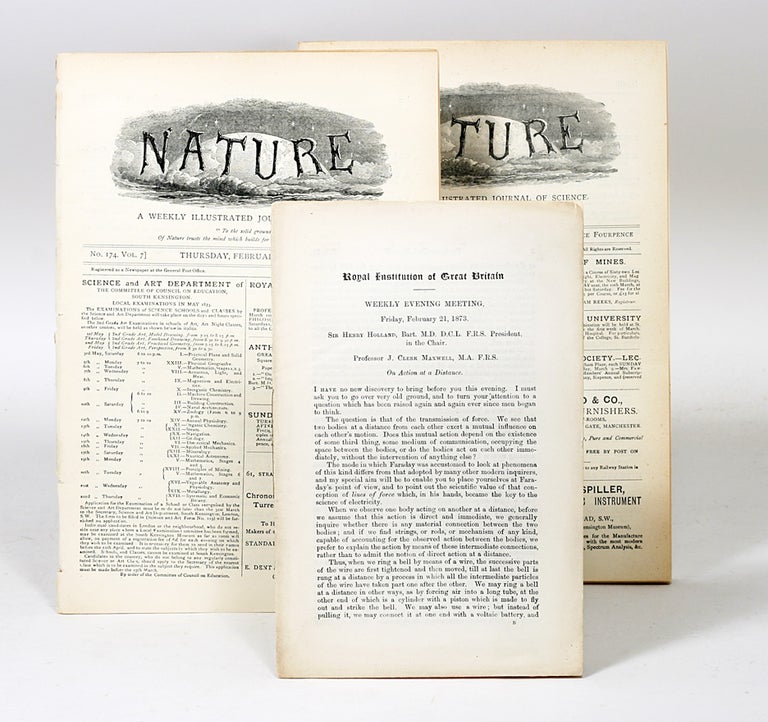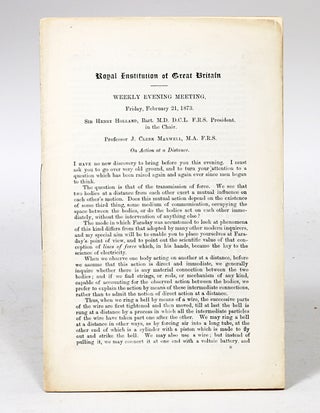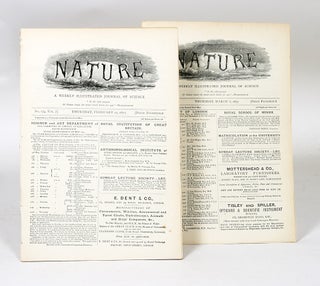On Action at a Distance
”The question is that of the transmission of force. We see that two bodies at a distance from each other exert a mutual influence on each other's motion. Does this mutual action depend on the existence of some third thing, some medium of communication, occupying the space between the bodies, or do the bodies act on each other immediately, without the intervention of anything else?”
EXTREMELY SCARCE FIRST EDITION OFFPRINT AND FIRST JOURNAL APPEARANCE IN RARE ORIGINAL WRAPPERS OF MAXWELL’S IMPORTANT CONTRIBUTION TO ONE OF THE MOST SIGNIFICANT AND ENDURING DEBATES IN PHYSICS.
“‘Action at a distance’ may sounds like some bizarre parapsychological notion, but it actually first appeared in Western science in Newton’s theory of gravity (1687). Newton’s gravitational law reads, in modern language, ‘The gravitational force between two (spherical) objects is inversely proportional to the square of the distance between them, and directed at each instant along the line connecting their centers.’ Thus, in Newton’s conception, one could send a message instantaneously to Jupiter by vibrating a large mass on Earth and detecting the resulting wiggle in a finely-suspended needle on Jupiter. This is action at a distance...
“In Newton’s time, the followers of Rene Descartes lodged strong protests against this idea as deviating from the philosophically proper mechanical view of Nature into a blatant mysticism. In the nineteenth century, Maxwell’s theory of electricity and magnetism did not rely on action at a distance, nor did the ’continuum’ theories of elasticity or hydrodynamics. Newtonian gravity became the anomalous case among physicists’ theories. After a decade-long struggle, Einstein succeeded in banishing action at a distance from physics with his general theory of relativity (1915). With the success of Einstein’s program, most physicists thought action at a distance had been permanently eliminated, to the betterment of science.” (David Wick, The Infmaous Boundary: Seven Decades of Controversy in Quantum Physics).
But the question of “action-at-a-distance has not gone away. It has returned, with major implications for the view of Nature, under the heading of non-locality in quantum mechanics. This described empirically well-established non-local correlations between spatially separated particles, between which any ordinary causal influences have been excluded. These correlations post a considerable challenge to a causal interpretation of the quantum world.” (Friedel Weinert, The Scientist as Philosopher).
In a public lecture, delivered to the prestigious Royal Institution of Great Britain on February 21, 1873, Maxwell, with great detail and consideration, presented his position in the debate.
After providing compelling evidence for the possibility of action at a distance, Maxwell, rather, sides with the new field theories developed by himself, Faraday, and others, in imagining the world fully interconnected where action must indeed travel over a distance:
”The vast interplanetary and interstellar regions will no longer be regarded as waste places in the universe, which the Creator has not seen fit to fill with the symbols of the manifold order of His kingdom. We shall find them to be already full of this wonderful medium; so full, that no human power can remove it from the smallest portion of space, or produce the slightest flaw in its infinite continuity. It extends unbroken from star to star; and when a molecule of hydrogen vibrates in the dog-star, the medium receives the impulses of these vibrations; and after carrying them in its immense bosom for three years, delivers them in due course, regular order, and full tale into the spectroscope of Mr Huggins, at Tulse Hill.
“But the medium has other functions and operations besides bearing light from man to man, and from world to world, and giving evidence of the absolute unity of the metric system of the universe. Its minute parts may have rotatory as well as vibratory motions, and the axes of rotation form those lines of magnetic force which extend in unbroken continuity into regions which no eye has seen, and which, by their action on our magnets, are telling us in language not yet interpreted, what is going on in the hidden underworld from minute to minute and from century to century.”
Maxwell’s electromagnetic theory was the crowning achievement of nineteenth century physics and forced the scientific world to re-evaluate their understanding of the nature and possible mechanisms for “action” in all its forms; his views, therefore, on the issue of action at a distance are of great weight and significance in the history of science.
Offprint from the Royal Institution of Great Britain. Octavo, original self-wrappers; 11 pages. [No date of printing]: From the meeting of Friday, February 21, 1873. Journal publication: IN: Nature, No. 174, Vol. 7, February 27, 1873, pp. 323-325; Nature, no. 175, Vol. 7, March 6, 1873, pp. 341-343. Quarto, original wrappers. Two complete issues. FINE COPIES. RARE.
Check Availability:
P: 212.326.8907
E: michael@manhattanrarebooks.com



